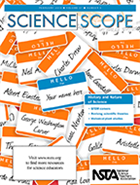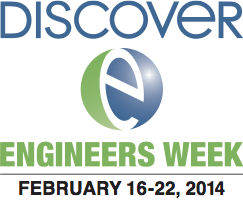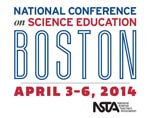The National Science Teachers Association (NSTA) has adopted a new position statement, the Early Childhood Science Position Statement. This thoughtful document was inspired by the clamor of early childhood educators looking for guidance informed by research on how to approach science teaching in the preschool years (ages 3–5) before kindergarten.

Educators and families can support young children’s interest in learning about science and engineering concepts.
Drawing on research from the National Research Council, the National Association for the Education of Young Children and others, the NSTA Position Statement on Early Childhood Science Education “… affirms that learning science and engineering practices in the early years can foster children’s curiosity and enjoyment in exploring the world around them and lay the foundation for a progression of science learning in K–12 settings and throughout their entire lives.”
The position statement supports early childhood educators who seek to honor young children’s “capacity for constructing conceptual learning and the ability to use the practices of reasoning and inquiry” at a developmentally appropriate level. Early childhood educators are urged to “take advantage of what children do as part of their everyday life prior to entering formal school settings [because] these skills and abilities can provide helpful starting points for developing scientific reasoning.” The Early Childhood Science position statement complements the position statement on elementary science education adopted by the NSTA Board of Directors in July 2002.

A 1-yr-old exploring water learns about the properties of liquids with adult guidance and support.
NSTA identifies six key principals to guide the learning of science by young children. In addition, declarations and recommendations further identify the following,
among others, as critical for high quality science learning environments: the nurturing of young children’s curiosity;
the understanding that everyday play is part of science learning;
and supportive educators who are prepared to carefully plan open-ended, inquiry-based explorations.
I am grateful to Cindy Workosky, NSTA Communications Specialist, who spearheaded the effort and the NSTA panel members who wrote the Early Childhood Science position statement, Susan Catapano (Chair), Peggy Carlisle, Christine Chaille, Ingrid Chalufour, Linda Froschauer, Rochel Gelman, Julie McGough, William C. Ritz, Jennifer S. Thompson, and Karen Worth. (See the full list of panel members below.)
I thank the NSTA Board of Directors for their forward-thinking action in adopting the work of the panel, and all those educators who commented on the first draft.
The position statement is a document that will inform my teaching practice and writing. It reminds me to intentionally prepare the environment and experiences to allow children to fully engage with the materials and provide time to talk about those experiences. I can share it with the program directors and school principals I work with to help them understand that science and engineering learning begins in the early years before kindergarten, when children are given multiple opportunities to engage in science exploration and experiences through inquiry. It will guide programs, school districts and states as they write new early childhood science standards and curriculum.
Take a look at the newly issued Early Childhood Science Education Position Statement online or in the February 2013 issue of
Science and Children, print out a copy to share with your colleagues and the families of your students, and talk about how it will support and possibly change your teaching.
Panel, NSTA Early Childhood Science Position StatementSusan Catapano, ChairChair and Professor, International CoordinatorWatson College of Education, University of North Carolina at Wilmington, Wilmington, NC
Peggy Carlisle (NSTA Board)
NSTA Director, Preschool/Elementary Div.
Gifted Education Teacher, Pecan Park Elementary, Jackson, MS
Christine Chaille
Professor and Chair, Curriculum and Instruction
Portland State University, Portland, OR
Ingrid Chalufour
Education Consultant
Brunswick, ME
Linda Froschauer
Field Editor, Science and Children
NSTA Past President
Westport, CT
Rochel Gelman
Distinguished Professor
Rutgers Center for Cognitive Science and the Psychology Department
Rutgers University, Busch Campus, Piscataway, NJ
Julie McGough
K-3 Primary Teacher, Valley Oak Elementary
Adjunct Faculty, Science Education
California State University, Fresno, Fresno, CA
William C. Ritz
Professor Emeritus, Science Education
Director, “A Head Start on Science”
California State University at Long Beach, Long Beach, CA
Jennifer S. Thompson (NSTA Council)
NSTA Director, District XVII
K-1 Primary Teacher, Harborview Elementary
Adjunct Faculty, Education
University of Alaska Southeast, Juneau, AK
Karen Worth
Instructor, Elementary Education Department & Department Chair
Wheelock College, Boston, MA
|



 If you think that the “history and nature of science” means students reading biographies of scientists of the past, your thoughts may change after browsing this issue of Science Scope. These articles represent lessons that incorporate the past, present, and future of science.
If you think that the “history and nature of science” means students reading biographies of scientists of the past, your thoughts may change after browsing this issue of Science Scope. These articles represent lessons that incorporate the past, present, and future of science.
 SUPERCOOL! More than just an expression, this state of water figures prominently in snow formation. Find out more about snow and how snow conditions might impact winter Olympians whose gold medals are inextricably linked to this frozen base material. Sarah Konrad—a glaciologist and a former Olympian—gives us a unique perspective on the Science of Snow, from the video series developed by NBC Learn and NSF.
SUPERCOOL! More than just an expression, this state of water figures prominently in snow formation. Find out more about snow and how snow conditions might impact winter Olympians whose gold medals are inextricably linked to this frozen base material. Sarah Konrad—a glaciologist and a former Olympian—gives us a unique perspective on the Science of Snow, from the video series developed by NBC Learn and NSF. BTW, you might have experience with supercooled fluids and not realized it. Ever pull your favorite “long-neck” beverage out of the frig, open it, and set it down rather hard on the counter, only to have it completely freeze up? Right. Super cool!
BTW, you might have experience with supercooled fluids and not realized it. Ever pull your favorite “long-neck” beverage out of the frig, open it, and set it down rather hard on the counter, only to have it completely freeze up? Right. Super cool! Imagine locking both feet onto a board, hurtling down a vertical face and up the opposing one before becoming airborne, where you twist and flip with near abandon. Now, imagine doing that with the equivalent weight of five people clinging to your back! If you can (and you have fiery red hair) then you might be channeling Shaun White—the former gold medalist competing in the 2014 Olympic halfpipe event on February 11. To prep yourself, take a look at Shaun White & Engineering the Halfpipe, one of ten videos from NBC Learn/NSF focused on the science of and engineering behind the 2014 Winter Olympic Games.
Imagine locking both feet onto a board, hurtling down a vertical face and up the opposing one before becoming airborne, where you twist and flip with near abandon. Now, imagine doing that with the equivalent weight of five people clinging to your back! If you can (and you have fiery red hair) then you might be channeling Shaun White—the former gold medalist competing in the 2014 Olympic halfpipe event on February 11. To prep yourself, take a look at Shaun White & Engineering the Halfpipe, one of ten videos from NBC Learn/NSF focused on the science of and engineering behind the 2014 Winter Olympic Games.


 My colleague and I are early–career science teachers at a middle school. Rather than our reinventing the wheel, do you have any suggestions how to make lab days run more smoothly, especially at the beginning and end of the class?
My colleague and I are early–career science teachers at a middle school. Rather than our reinventing the wheel, do you have any suggestions how to make lab days run more smoothly, especially at the beginning and end of the class?